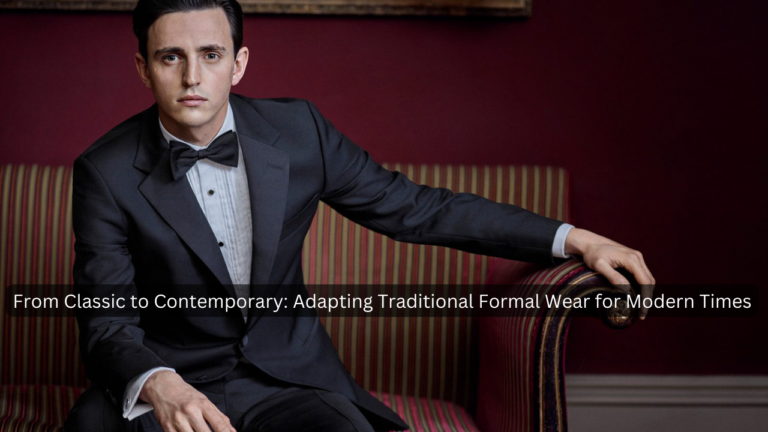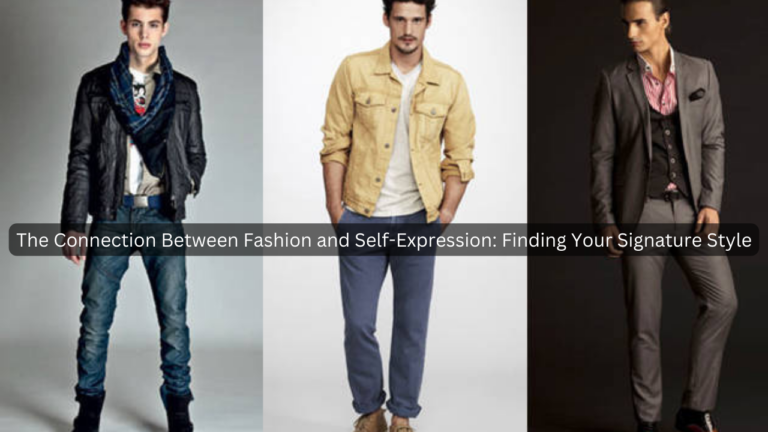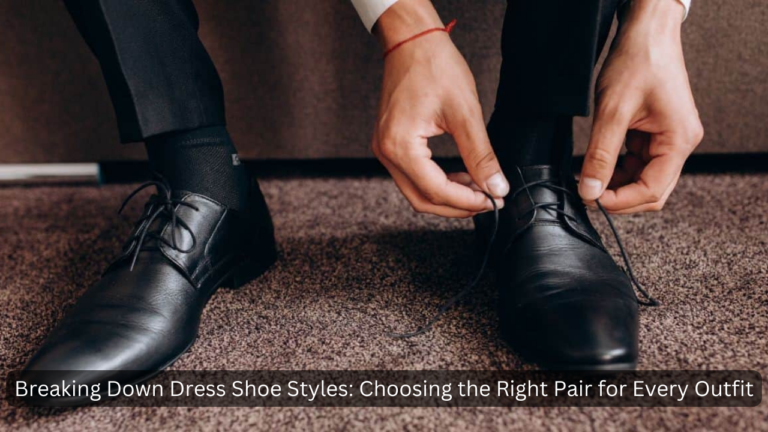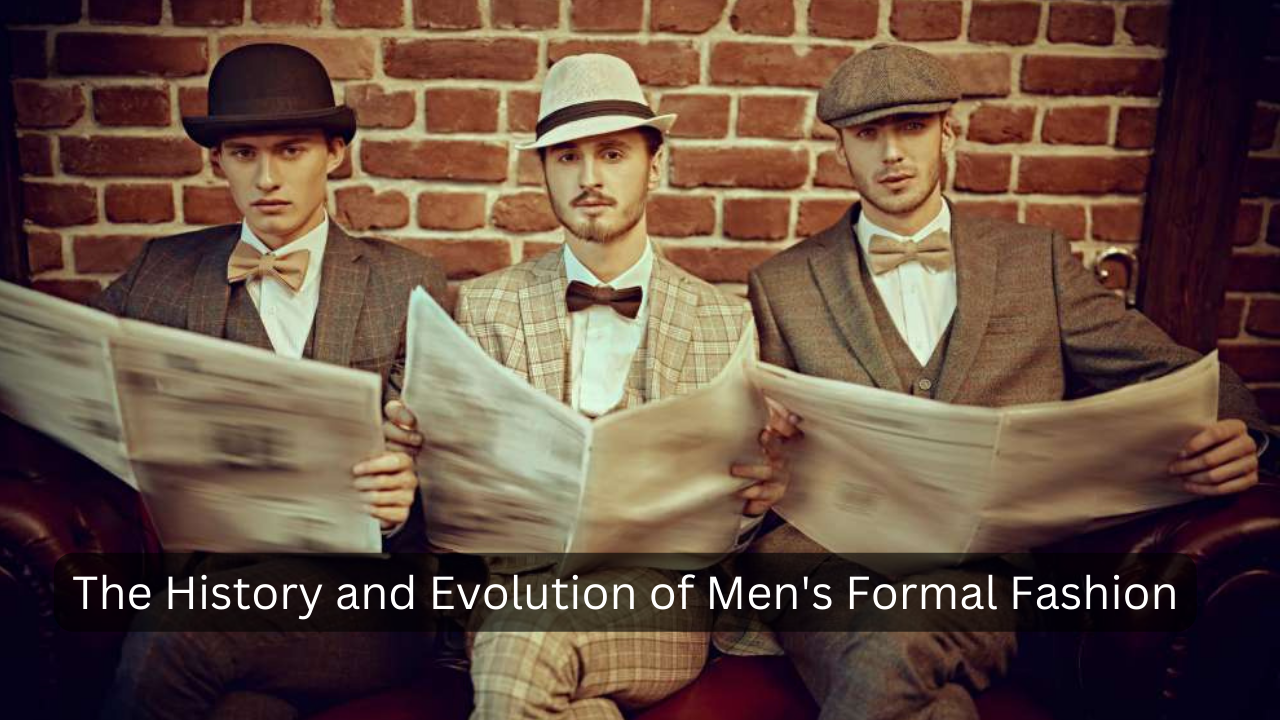
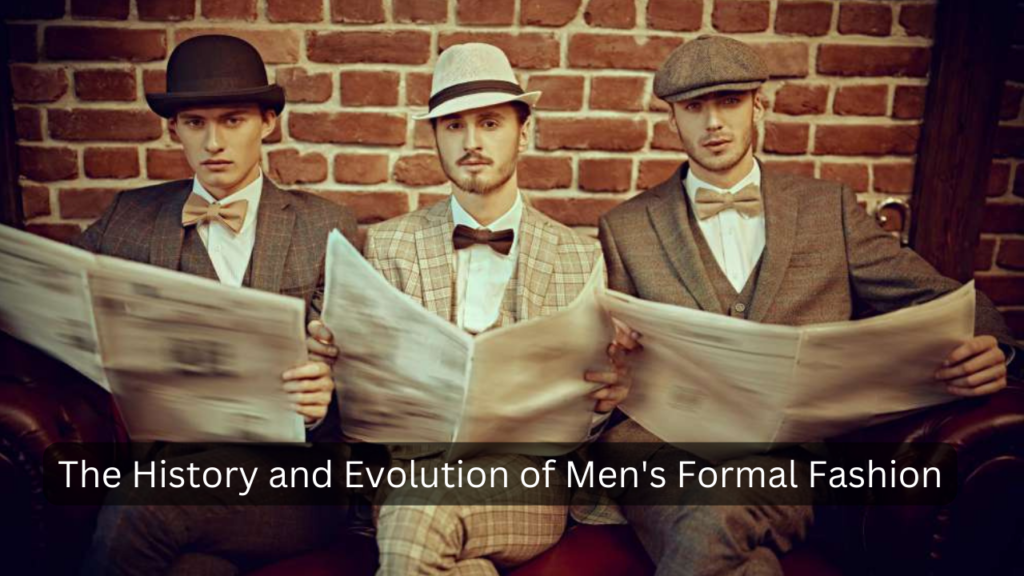
Table of Contents
Introduction
Men’s formal fashion is a dynamic reflection of cultural shifts, social norms, and artistic expression throughout history. From ancient civilizations to modern-day trends, the evolution of men’s formal attire encapsulates a journey of style, functionality, and societal significance. This exploration delves into the rich tapestry of men’s formal fashion, tracing its roots from antiquity to contemporary times, and highlighting the intricate interplay of tradition and innovation that has shaped this aspect of sartorial culture.
Definition of Formal Fashion:
Formal fashion refers to a category of clothing characterized by its elegance, sophistication, and adherence to established dress codes. It typically includes attire worn for special occasions, ceremonies, professional settings, or evening events where a certain level of decorum is expected. Men’s formal fashion often encompasses tailored suits, tuxedos, dress shirts, ties, formal trousers, and appropriate footwear like dress shoes. The design and construction of formal garments emphasize precision, fit, and fine craftsmanship, reflecting a sense of refinement and attention to detail.
Importance and Significance:
The significance of men’s formal fashion lies in its role as a symbol of respect, professionalism, and social status. Formal attire conveys a sense of authority, competence, and attention to detail in professional environments such as business meetings, conferences, and formal gatherings. It also plays a crucial role in ceremonial events, cultural celebrations, and special occasions like weddings, where dressing formally is a sign of reverence and adherence to tradition.
Furthermore, men‘s formal fashion carries historical and cultural significance, reflecting the values, norms, and aesthetics of different eras and ties. It serves as a visual representation of societal expectations, etiquette standards, and personal identity, allowing individuals to express themselves while adhering to established dress codes and conventions. As such, the evolution of men’s formal clothes fashion mirrors broader changes in societal attitudes, fashion trends, and technological advancements, making it a fascinating aspect of cultural heritage and artistic expression.
Ancient Times
In ancient civilizations, men’s formal fashion held a deep cultural and symbolic significance, reflecting the societal hierarchy, religious beliefs, and ceremonial practices of the time.
- Egyptian Influence:
In ancient Egypt, clothing played a crucial role in denoting social status and identity. Men of higher rank and nobility often wore linen kilts, elaborate jewelry, and headdresses adorned with precious stones. Formal attire symbolized power, wealth, and divine connection, with pharaohs and priests donning intricate robes and ceremonial garments during religious rituals and public ceremonies.
- Greek Garments:
Ancient Greece introduced a variety of clothing styles for men, with formal attire varying based on the occasion and social standing. The chiton, a draped garment made of linen or wool, was common among men of all classes. However, aristocrats and officials often wore more elaborate tunics, cloaks, and himations, showcasing their status and role in society. Formal events like banquets, festivals, and theatrical performances called for refined clothing, reflecting Greek ideals of beauty, harmony, and cultural sophistication.
- Roman Togas:
In the Roman Empire, the toga was a quintessential symbol of Roman citizenship and authority. Men of prominence and political influence wore the toga, a large draped garment made of wool, in various styles denoting their rank and role in society. Formal occasions such as public speeches, legal proceedings, and religious ceremonies required the wearing of the toga, underscoring the importance of formal attire in Roman civic life.
Overall, in ancient times, men’s formal fashion not only served practical purposes but also carried profound cultural, social, and religious significance, shaping perceptions of power, prestige, and identity within ancient civilizations.
Medieval Period
The Medieval period witnessed a distinctive evolution in men’s formal fashion, characterized by a blend of practicality, symbolism, and artistic expression.
- Tunics and Robes:
During the early Medieval period, men’s formal attire primarily consisted of tunics, robes, and cloaks made from sturdy fabrics like wool or linen. These garments varied in length, style, and decoration based on one’s social status and profession. Nobility often wore richly embroidered tunics and fur-trimmed robes, showcasing their wealth and elevated position in society.
- Nobility and Luxury Fabrics:
The clothing of medieval noblemen was not just a matter of practicality but also a symbol of their status and power. They favored luxurious fabrics such as silk, velvet, and brocade, which were often imported and meticulously crafted to create elaborate designs and patterns. Fine embroidery, intricate weaving techniques, and embellishments with gold or silver thread were common features of noble attire, highlighting their prestige and refinement.
- Ceremonial Attire:
Formal occasions in the Medieval period, such as royal ceremonies, feasts, and religious events, called for specific ceremonial attire. This included ceremonial robes, mantles, and coronation garments adorned with symbols of authority and religious motifs. The attire worn by kings, knights, and clergy during these events was carefully chosen to convey hierarchy, tradition, and the divine mandate of rulership.
Overall, the Medieval period marked a significant transition in men’s formal fashion, with clothing becoming more than just practical garments but also powerful symbols of social status, authority, and cultural identity. The elaborate designs, luxurious fabrics, and symbolic elements of medieval attire continue to inspire fashion and historical reenactments to this day.
Renaissance Era
The Renaissance era was a pivotal period in the history of men’s formal fashion, marked by a resurgence of classical styles, artistic innovation, and a newfound emphasis on elegance and refinement.
- Revival of Classical Styles:
The Renaissance witnessed a renewed interest in the art, literature, and culture of ancient Greece and Rome. This revival of classical ideals extended to men’s fashion, with a shift towards more structured and tailored clothing inspired by Greco-Roman garments. The silhouette became more fitted, emphasizing the natural contours of the body and creating a sense of balance and proportion.
- Doublets, Hose, and Codpieces:
Key elements of Renaissance men’s formal attire included the doublet, a close-fitting jacket worn over a shirt, and hose, which were snug-fitting trousers often made of silk or wool. These garments were often embellished with intricate embroidery, lace collars, and decorative elements like buttons or jewels. Codpieces, pouch-like additions to the front of the hose, also became fashionable, serving both practical and symbolic purposes.
- Elegance and Functionality:
Renaissance fashion for men combined elegance with functionality. Clothing was designed to be both aesthetically pleasing and practical for daily activities. Fabrics such as silk, velvet, and brocade were favored by the wealthy elite, while simpler materials like wool and linen were more common among the middle classes. The emphasis on fine tailoring and craftsmanship resulted in garments that draped well and accentuated the wearer’s stature.
- Cultural Influence:
Men’s formal fashion during the Renaissance was influenced by cultural and artistic movements of the time. Renaissance artists depicted fashionable attire in their paintings and portraits, showcasing the latest trends in clothing and accessories. This visual representation of fashion ideals contributed to the dissemination of style across different social strata and regions.
Overall, the Renaissance era marked a golden age of men’s formal fashion, characterized by a fusion of classical aesthetics, artistic creativity, and a growing emphasis on personal style and expression. The legacy of Renaissance fashion continues to inspire contemporary designers and enthusiasts seeking to capture the timeless elegance and sophistication of this period.
17th and 18th Centuries:
The 17th and 18th centuries were pivotal periods in the evolution of men’s formal fashion, marked by the rise of tailored suits, luxurious fabrics, and distinctive styles that reflected the social and cultural trends of the time.
- Rise of Tailored Suits:
The 17th century saw the emergence of tailored suits as a standard formal attire for men. These suits typically consisted of a coat, waistcoat (vest), and breeches (short trousers), often made from fine wool or silk fabrics. Tailoring techniques advanced during this period, allowing for a more fitted and structured silhouette that emphasized the natural contours of the body.
- Three-Piece Suit:
By the 18th century, the three-piece suit had become a staple of men’s formal fashion. The coat, waistcoat, and breeches were coordinated in color and fabric, creating a cohesive and elegant ensemble. The waistcoat, in particular, became a prominent element of formal attire, often elaborately embroidered or embellished to showcase wealth and status.
- European Aristocracy’s Influence:
Fashion trends in the 17th and 18th centuries were heavily influenced by the European aristocracy. Noblemen and courtiers set the standards for formal wear, favoring richly textured fabrics, intricate embroidery, and decorative elements such as lace, brocade, and velvet. These luxurious materials were often imported from exotic locations and reflected the opulence of the upper class.
- Evolution of Accessories:
Accessories played a significant role in men’s formal fashion during this period. Lace cravats, ruffled shirts, silk stockings, and elaborate waistcoats were common accessories that added flair and sophistication to the ensemble. Wigs, particularly powdered wigs, were also popular among the elite and were considered a symbol of refinement and status.
- Regional Variations:
Different regions in Europe developed their distinct styles of formal fashion during the 17th and 18th centuries. For example, the French court influenced fashion with its ornate and extravagant designs, while English tailors developed a reputation for their understated elegance and emphasis on quality craftsmanship.
In summary, the 17th and 18th centuries marked a period of refinement and elegance in men’s formal fashion, with tailored suits, luxurious fabrics, and intricate detailing becoming defining features of formal attire for men of wealth and status. These centuries laid the foundation for the modern suit and continue to inspire contemporary fashion trends.
19th Century
The 19th century was a transformative period in men’s formal fashion, witnessing significant shifts in styles, fabrics, and cultural influences that laid the groundwork for modern menswear.
- Industrial Revolution Impact:
The Industrial Revolution brought about profound changes in the textile industry, leading to the mass production of fabrics and clothing. This revolutionized men’s formal fashion by making ready-made clothing more accessible to a wider range of people, not just the affluent elite. Tailoring techniques also advanced, allowing for more precise and efficient production of suits and formal attire.
- Ready-Made Clothing:
The availability of ready-made clothing in the 19th century revolutionized men’s fashion. Tailored suits, coats, trousers, and shirts could now be purchased off the rack, reducing the need for custom tailoring and making formal wear more affordable and convenient for the growing middle class.
- Evolution of Suit Designs:
The 19th century saw the evolution of suit designs towards the modern silhouette. The frock coat, characterized by a knee-length cut and a fitted waist, was a popular formal garment in the early 1800s. As the century progressed, the frock coat gave way to the morning coat (cutaway coat) for daytime formal events and the tailcoat (evening coat) for evening wear.
- Influence of Beau Brummell:
The dandyism of Beau Brummell, a prominent figure in Regency England, had a profound impact on men’s formal fashion in the early 19th century. Brummell popularized the tailored suit with a close-fitting silhouette, emphasizing simplicity, elegance, and impeccable grooming. His influence extended to grooming habits, such as daily bathing and meticulous attention to personal hygiene.
- Victorian Era Elegance:
The latter half of the 19th century, known as the Victorian era, was characterized by a more conservative and structured approach to men’s fashion. Suits became more tailored, with an emphasis on a fitted waist, broad shoulders, and a straighter cut. Fabrics like wool, tweed, and worsted became popular for suits, reflecting a preference for durability and practicality.
- Formal Accessories:
Accessories continued to play a crucial role in men’s formal fashion during the 19th century. Cravats, neckties, and bowties were worn with formal shirts, while top hats, gloves, and walking sticks added a touch of elegance to formal attire. The pocket watch also became a popular accessory, carried in a waistcoat pocket attached to a chain.
Overall, the 19th century was a period of transition and innovation in men’s formal fashion, with the influence of industrialization, cultural movements, and iconic figures shaping the styles and aesthetics that continue to influence menswear today.
Early 20th Century
The early 20th century was a dynamic period in men’s formal fashion, marked by a blend of traditional styles and emerging trends that reflected the shifting societal norms and cultural influences of the time.
- Lounge Suits:
The early 1900s saw the rise of lounge suits as a versatile and practical alternative to more formal attire. Lounge suits, consisting of a jacket and trousers, became popular for everyday wear and less formal occasions. These suits were characterized by a looser fit and softer fabrics compared to formal suits, reflecting a shift towards comfort and functionality.
- Influence of World War :
World War I had a significant impact on men’s fashion, leading to changes in clothing styles and materials. Military uniforms influenced civilian clothing, with features like epaulets, trench coats, and utility pockets becoming fashionable. The war also led to a simpler and more practical approach to fashion, as elaborate and extravagant styles fell out of favor during this period.
- Rise of Sportswear:
The early 20th century witnessed the rise of sportswear and casual clothing, which had an influence on men’s fashion. Knitwear, polo shirts, and casual trousers became popular for leisure activities and informal gatherings, blurring the lines between formal and casual attire.
- Sartorial Innovations:
Tailoring techniques continued to evolve in the early 20th century, with innovations such as the introduction of the two-button jacket and the development of structured shoulder pads. These innovations contributed to a more streamlined and modern look in men’s suits, emphasizing a clean and tailored silhouette.
- Evening Wear:
Formal evening wear remained an important aspect of men’s fashion in the early 20th century. The tuxedo, with its satin lapels and trousers, became a staple for formal events and evening occasions. White tie and tails were also worn for the most formal events, maintaining a sense of elegance and tradition in evening wear.
- Cultural Influences:
The early 20th century was a period of cultural and artistic movements that influenced fashion. The Art Deco style, with its geometric patterns and sleek lines, had an impact on men’s clothing designs. Hollywood stars and celebrities also played a role in popularizing certain fashion trends, making menswear more accessible and aspirational.
Overall, the early 20th century saw a transition towards more casual and practical styles in men’s fashion, while still maintaining a sense of elegance and formality for special occasions and formal events. This period laid the foundation for the diverse range of styles and options available in men’s formal and casual wear today.
Mid-20th Century
The mid-20th century was a period of significant evolution and diversification in men’s formal fashion, influenced by post-war prosperity, cultural movements, and technological advancements. This era witnessed a range of styles that reflected the changing societal norms and fashion preferences of the time.
- Post-WWII Rejuvenation:
The aftermath of World War II brought a sense of optimism and prosperity, leading to a resurgence of interest in fashion and style. Men’s formal fashion experienced a revival, with a focus on tailored suits, clean lines, and classic silhouettes. The “New Look” in menswear emphasized a trim waist, broad shoulders, and tapered trousers, creating a sharp and sophisticated appearance.
- Business Attire:
The mid-20th century saw the establishment of business attire as a distinct category in men’s fashion. The business suit became a symbol of professionalism and success, with darker colors like navy, charcoal, and black being preferred for suits worn in corporate settings. The traditional three-piece suit with a matching vest remained a staple for business executives and professionals.
- Casualization of Fashion:
Alongside formal wear, the mid-20th century also witnessed a trend towards more casual and relaxed styles. The adoption of sports jackets, polo shirts, and chinos for everyday wear reflected a shift towards comfort and informality, especially in leisure and social settings.
- Ivy League Influence:
The Ivy League style, popularized by American universities like Harvard and Yale, had a significant impact on men’s fashion during this period. Elements such as Oxford shirts, khaki trousers, blazers, and loafers became iconic components of preppy and collegiate-inspired looks.
- Cultural Icons:
The mid-20th century was also marked by the influence of cultural icons and celebrities on men’s fashion. Hollywood stars like Cary Grant, James Dean, and Frank Sinatra set trends with their distinctive styles, contributing to the popularity of certain garments and accessories such as fedoras, leather jackets, and Wayfarer sunglasses.
- Formal Evening Wear:
Formal evening wear continued to evolve in the mid-20th century, with the tuxedo remaining a classic choice for formal events and black-tie affairs. Variations in lapel styles, fabrics, and accessories added versatility and flair to evening wear options for men.
Overall, the mid-20th century was a period of diverse styles and influences in men’s formal fashion, blending traditional elegance with modern sensibilities. This era laid the groundwork for the continued evolution and innovation in menswear that followed in subsequent decades.
Post-WWII to Present
The period following World War II to the present day has been a dynamic and transformative era in men’s formal fashion, characterized by a blend of traditional elements, cultural influences, and innovative designs. Let’s explore the key trends and developments that have shaped men’s formal attire during this time frame.
- 1950s – The Golden Age of Tailoring:
The 1950s marked a return to elegance and refinement in men’s fashion after the austerity of wartime clothing. Tailored suits with sharp silhouettes, defined shoulders, and narrow lapels became popular. The “New Look” in menswear emphasized a slim waist and a more structured fit, highlighting a sense of confidence and sophistication.
- 1960s – Mod Fashion and Casual Revolution:
The 1960s witnessed the rise of mod fashion, characterized by bold patterns, vibrant colors, and slim-fitting suits with shorter jackets. This decade also saw a casual revolution with the popularity of sportswear-inspired styles like polo shirts, Harrington jackets, and chinos, reflecting a more relaxed approach to dressing.
- 1970s – Bold Colors and Disco Influence:
The 1970s brought a flamboyant and expressive style to men’s fashion. Wide lapels, bell-bottom trousers, and bold patterns dominated formal wear. The disco era influenced fashion with shiny fabrics, flashy accessories, and exaggerated collars, reflecting the exuberance of the time.
- 1980s – Power Suits and Excess:
The 1980s ushered in the era of power dressing, characterized by oversized suits with padded shoulders, wide lapels, and bold pinstripes. The “Wall Street” look became iconic, symbolizing wealth, success, and corporate power. Accessories like suspenders, bold ties, and statement watches were also popular during this period.
- 1990s – Casualization and Minimalism:
The 1990s saw a shift towards more casual and minimalist styles in men’s fashion. Suits became slimmer and more understated, with neutral colors and simpler designs. Casual wear like denim jackets, T-shirts, and sneakers gained popularity, reflecting a relaxed and effortless aesthetic.
- 2000s to Present – Contemporary Trends:
In recent years, men’s formal fashion has embraced a mix of classic elegance and contemporary trends. Tailored suits remain timeless, with a focus on quality fabrics, impeccable fit, and versatility. Customization and personalization have become key trends, allowing men to express their individual style through tailored garments and accessories.
- Sustainable Fashion and Ethical Choices:
In the present day, there’s a growing emphasis on sustainable fashion and ethical choices in menswear. Eco-friendly fabrics, ethical production practices, and conscious consumerism are influencing the way men approach their clothing choices, highlighting a shift towards more responsible and mindful fashion.
Overall, the post-WWII to present era has seen a diverse range of styles, trends, and influences in men’s formal fashion, reflecting the ever-changing cultural, social, and economic landscape of the times.
Conclusion
The history and evolution of men’s formal fashion present a captivating journey through time, reflecting the dynamic interplay of cultural influences, societal norms, and individual expression. From ancient times to the present day, formal attire for men has evolved significantly, shaping and reflecting the values, aesthetics, and technological advancements of each era.
Throughout history, formal fashion has been more than just clothing; it’s been a means of communication, a symbol of status, and a reflection of cultural identity. Ancient civilizations used attire to denote social hierarchy and ceremonial importance, while medieval and Renaissance periods saw the emergence of elaborate garments that showcased wealth and artistic craftsmanship.
The 17th and 18th centuries introduced tailored suits and luxurious fabrics, setting the stage for the modern suit as we know it. The 19th century witnessed industrialization’s impact, making formal wear more accessible while maintaining elegance and style. The early 20th century saw a blend of traditional and casual styles, influenced by post-war optimism and cultural movements.
The mid-20th century brought about diverse trends, from the elegance of business attire to the casual revolution of mod fashion and the flamboyance of disco influence. The latter part of the 20th century and the present day have seen a mix of classic elegance and contemporary trends, with an emphasis on sustainability, customization, and ethical choices.
In conclusion, men’s formal fashion has evolved in response to societal changes, technological innovations, and individual preferences, yet it has always maintained a sense of sophistication, elegance, and cultural significance. As we move forward, the continued evolution of men’s formal fashion will likely continue to be influenced by a blend of tradition, innovation, and social consciousness, shaping the way men dress and express themselves for generations to come.
Summary of Evolution:
The evolution of men’s formal fashion spans centuries and encompasses a rich tapestry of styles, influences, and innovations. It began with ancient civilizations using attire to denote social status and ceremonial importance, evolved through medieval and Renaissance periods with elaborate garments showcasing wealth and craftsmanship, and progressed into the modern era with tailored suits, sustainable practices, and a blend of classic elegance and contemporary trends.
Impact of Cultural, Economic, and Technological Changes:
Cultural, economic, and technological changes have profoundly influenced men’s formal fashion over time. Cultural shifts have shaped aesthetic preferences, societal norms, and expressions of identity. Economic factors such as industrialization, globalization, and changing social classes have impacted accessibility, production methods, and affordability of formal wear. Technological advancements have revolutionized textile production, tailoring techniques, and sustainability practices, leading to a more diverse and responsible approach to men’s fashion.
Continued Sophistication and Elegance:
Despite evolving trends and influences, men’s formal fashion has maintained a sense of sophistication and elegance throughout history. Whether in ancient civilizations, medieval courts, or modern boardrooms, formal attire for men has always conveyed a sense of respect, professionalism, and attention to detail. The enduring appeal of tailored suits, quality fabrics, and timeless designs reflects a timeless commitment to refinement and style, ensuring that men’s formal fashion continues to be a symbol of grace and distinction in the years to come.
